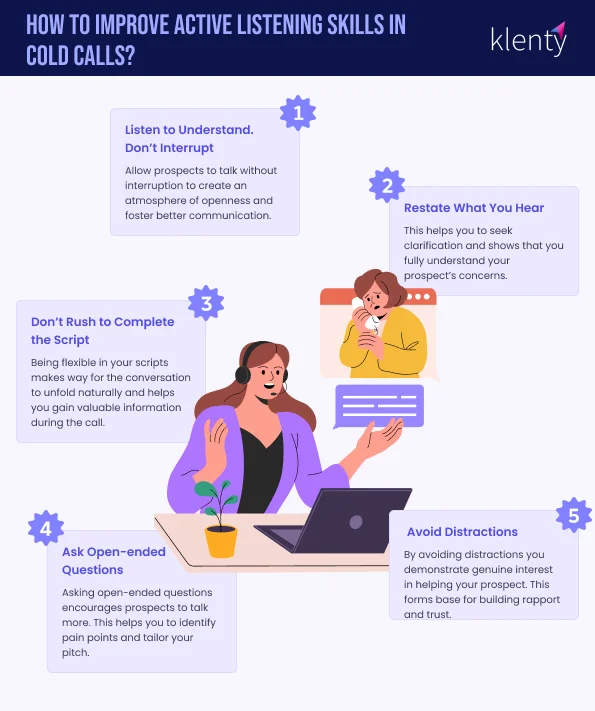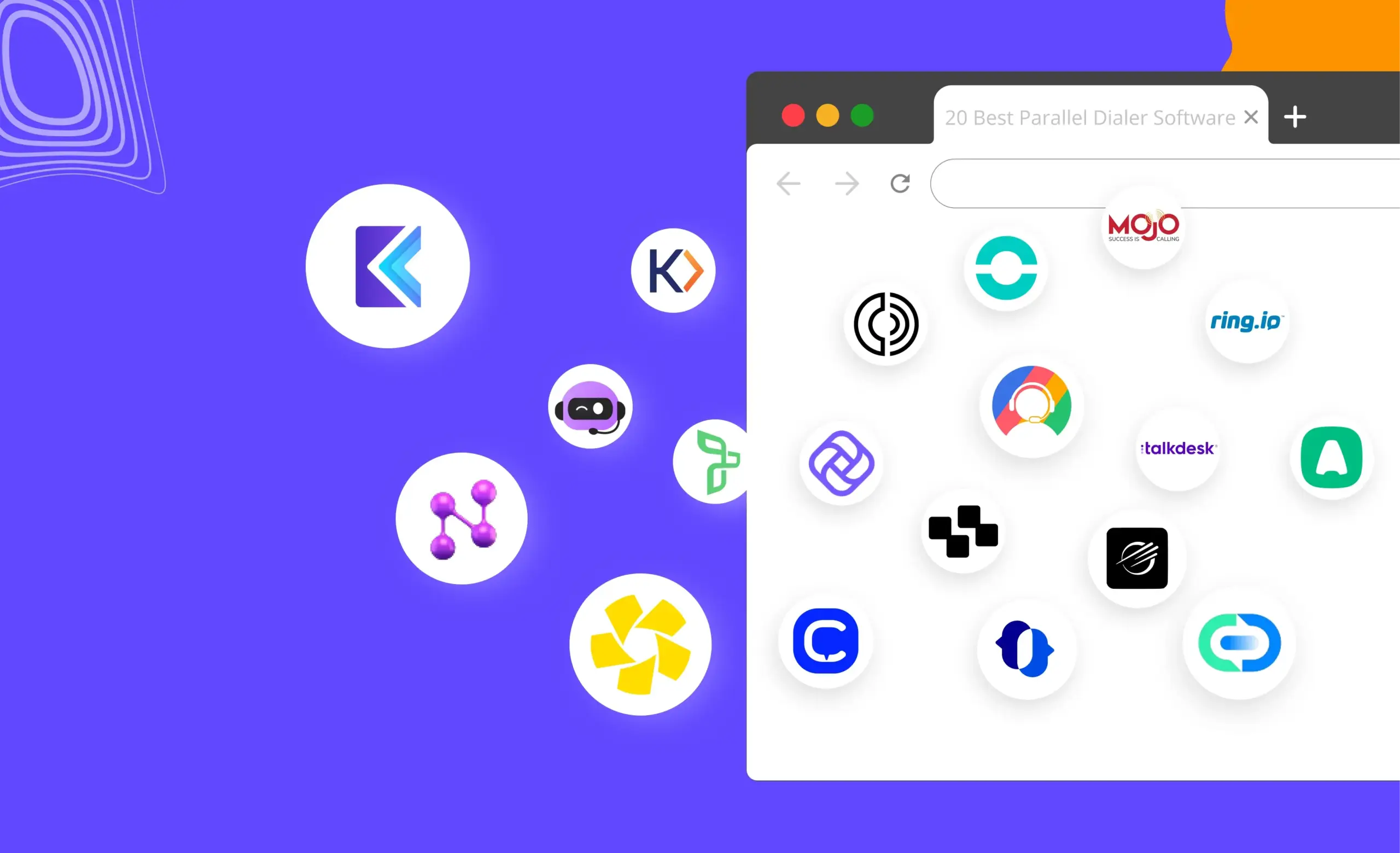Have you ever experienced that awkward moment when you find yourself desperately trying to escape a conversation where the other person just keeps talking and talking and talking without ever listening to you?
That's how your prospects feel during cold calls when you slam them with scripted pitches without making them care about whatever you're trying to sell.
Since it's a cold call, and prospects are in no way obligated to keep listening to you if they feel unheard and unimportant, they'll simply hit the end button.
And you’ll be left wondering what went wrong despite all your efforts and why the prospect isn’t answering any of your follow-up calls or emails.
French philosopher Blaise Pascal once wrote: "All of humanity's problems stem from man's inability to sit quietly in a room alone." To rephrase this for the modern sales rep, all of your cold calling problems stem from a lack of one crucial skill: active listening.
In this blog, we explain active listening in cold calls, why it is important, and how you can improve your active listening skills for productive interaction, boost cold calling efforts, and book more meetings.
What Is Active Listening?
Active listening in sales is a communication skill that involves fully focusing on, understanding, and responding to prospects during sales conversations.
The goal is to not only hear the words being spoken but also to comprehend the underlying message, emotions, and needs of the prospect you are interacting with.
Why Is Active Listening in Cold Calls Important?
Research states that great listeners are also seen as more trustworthy and empathetic.
So, if you want to foster a sense of trust, avoid misunderstandings, and establish strong relationships with prospects, you must understand them really well. And to do that, you need to listen to what your prospect wants.
Let’s delve deeper to understand how active listening helps you turn cold leads into warm leads and build meaningful connections:
Active Listening Helps Build Trust
In cold calls, prospects talk to reps with a degree of skepticism. They’re wary of sales pitches and don’t want to be pressured into a purchase they don't need.
Active listening helps break down this skepticism by demonstrating that your intention is not solely to push a product but to understand your prospects and address their specific requirements.
When you acknowledge the prospect's statements and validate their feelings or concerns during a conversation, it makes them feel heard and understood. This builds a stronger sense of trust and forms the basis for future conversations.
Active Listening Helps in Overcoming Objections
Active listening lets you pick up on subtle cues and signals during the conversation that indicate potential cold call objections. This lets you preempt objections—you can address their doubt before they say it out loud.
Also, when a prospect raises an objection directly, listening actively helps you respond with empathy and understanding and acknowledge the prospect's concern instead of immediately countering the objection. This demonstrates that you value their perspective and are not dismissive of their reservations.
Active Listening Helps Improve Adaptability
During a cold call, potential customers may raise concerns or priorities that were not addressed in your initial script or preparation. In such cases, continuing the conversation with stale, templated replies from your script could make you appear inconsiderate and even cause you to lose the prospect altogether.
So, the best way to make your cold call script adaptable is through active listening. Whatever unexpected objection the prospect might bring up, practicing active listening will help you think on your feet and handle the objection with confidence.
The result? The prospect will come to trust you better and be inclined to continue the conversation further, and you'll get that meeting booked.
Active Listening Helps Minimize Misinterpretations
In cold calls, you don't have the benefit of visual cues such as body language or facial expressions to gauge the prospect's reaction or understanding.
Here’s how active listening helps you avoid misunderstandings:
- Summarize accurately: Active listening helps you focus on verbal cues and tone of voice to summarize what the prospective customer has said and confirm your understanding to avoid misunderstandings.
- Seek clarification: If the prospect's statements are ambiguous or uncertain, active listening prompts you to seek clarification so you have a clear understanding of their needs, goals, and concerns. This minimizes the risk of misinterpretations that could potentially derail the conversation.
How Do You Know You’re Good at Active Listening? Track Your Talk-To-Listen Ratio
If you aim to turn conversations into successful outcomes, finding the right mix of talking and listening is crucial. A key aspect of active listening is ensuring that the conversation isn't dominated by one party but rather involves a healthy exchange of ideas. Unfortunately, many sales reps struggle with this balance.
One effective way to gauge your proficiency in active listening is by considering the talk-to-listen ratio.
The talk-to-listen ratio is a simple yet powerful metric that measures the proportion of time you spend talking versus the time spent actively listening to a conversation.
A higher talk-to-listen ratio may indicate a tendency to dominate the conversation, potentially hindering effective communication. On the other hand, a lower ratio suggests a focus on active listening, allowing for a more nuanced understanding of the other person's perspective.
According to a Gong Labs study of over 25,000 sales calls, top sales performers have a talk-to-listen ratio of 43:57. This means the top-performing reps speak 43% of the time and allow the prospects to speak 57% of the time during the call.
In the next section, we will see how you can balance your talk-to-listen ratio and improve your active listening skills, ultimately boosting your cold calling success.
How To Improve Active Listening Skills During Cold Calls?
It’s not that easy for sales reps to achieve the ideal talk-to-listen ratio of 43:57. In fact, the same study by Gong reveals that most sales reps struggle to balance and dominate 3/4ths of the conversation.
But here’s the good news: active listening is a skill that can be practiced and improved.
So, here are 5 cold calling strategies to ace active listening skills in cold calls:

1. Listen To understand. Don’t interrupt
Stephen R. Covey, in his book The 7 Habits of Highly Effective People, says, “Most people do not listen with the intent to understand; they listen with the intent to reply. ”
The same is true when you interrupt the flow of the conversation by interrupting your prospects. This is perceived as disrespectful and signals that you are more focused on what you want to say rather than understanding the prospect's perspective.
By allowing the prospect to speak without interruption, you show respect for their opinions and create an atmosphere of openness. This approach fosters better communication and allows you to gather more information about their needs and concerns.
2. Restate What You Hear
When a prospect shares their challenges or what they're seeking, it's crucial to reiterate what they've just said to demonstrate that you understand and to seek clarification if needed.
For example, you can say, "If I understand correctly, you mentioned that one of your main challenges is..." and briefly state what you have understood. Based on their reply, proceed with the conversation.
This technique not only shows your engagement but also helps in confirming your comprehension of the prospect's concerns. Plus, it reassures the potential customer that their thoughts are being accurately interpreted.
3. Don’t Rush To Complete the Script
While having a script is beneficial for maintaining structure, it's essential not to rush through it. The prospect may provide valuable information or insights during the conversation that could be missed if you are solely focused on delivering your script.
Be flexible, and allow the conversation to unfold naturally. This adaptability demonstrates that you’re responsive to the prospect's needs and not just following an ossified script.
4. Ask Open-Ended Questions
When you ask close-ended questions like “Are you looking to scale your company operations?” the answers are limited to yes/no, which means you’ll get only limited information. There won’t be scope for further conversation for you to listen.
Open-ended cold calling questions, on the other hand, explore beyond the surface and help you get to the root of your prospect's pain points.
So, ask probing, open-ended, and relevant follow-up questions that encourage prospects to express their needs, listen attentively to gauge their interests, and tailor your pitch accordingly.
Here are some examples of open-ended questions you can ask:
- What is one thing you would like to see done differently at this company?
- How do you envision you would be able to meet your deadline?
- What new features would you like added to this product?
5. Avoid Distractions
Imagine you're having a conversation with someone in real life, and the other person keeps checking their phone, says "uh-huh" to everything you say, and doesn't even look at you. How will you feel? That's how your potential clients will feel if you're talking to them while being distracted.
Distraction destroys active listening. When you're not attentively listening, you won't be able to restate what the prospect just told you, you'll be in a rush to finish your script, and might forget to ask pointed open-ended questions.
Your prospect might not be able to see you, but they can feel in your voice that you're not being attentive to what they're saying. And they'll turn you away.
So, place yourself in a quiet environment and be present 100% in your cold call.
How Can Sales Automation Tools Improve Active Listening in Cold Calls?
Active listening is tough during cold calls because sales reps have to juggle multiple tasks. They need to dial numbers one after the other, take notes, follow scripts, update their CRM after every call, and manage follow-up tasks. This poses a huge barrier to reps when it comes to being fully present during calls and understanding what the prospect is saying.
Sales automation tools come to the rescue by automating these manual tasks and freeing reps to practice active listening. These tools can automatically update CRM records in real time and take notes, saving reps from the hassle of doing so while on call.
With the sales automation tools, you can also do the following:
1. Automate Dialing
Some tools offer integrated dialers that ease the cold call process by automating the process of dialing phone numbers, saving you valuable time by eliminating the need to dial each prospect manually.
With this automation, you can make a higher volume of calls in less time, increasing your chances of reaching more potential leads. This means you can allocate more time to listen to prospects and tailor your pitch to their needs.
2. Gain Trust with Local Numbers
Many sales automation tools offer the feature of using local phone numbers when making calls. This can help sales reps build trust with prospects, as calls from local numbers are more likely to be answered than calls from unfamiliar or blocked numbers.
Using local numbers during cold calls increases your chances of connecting with prospects and starting meaningful conversations.
3. Review Your Calls
There are tools in the market that offer features for recording and analyzing calls By reviewing your calls, you can gain valuable insights into your interactions with prospects, identifying areas for improvement, and refining your cold calling approach.
Use these tools to monitor aspects such as your talk-to-listen ratio and tone of voice to gauge the effectiveness of your pitch and optimize your sales strategy.
If you’re looking for one platform that lets you do all these, look no further than Klenty.
How Can Klenty Help Sales Reps Improve Active Listening During Cold Calls?
Klenty is a sales engagement platform that helps mature sales teams engage prospects strategically across multiple channels, execute the right next step for every prospect, and generate a qualified pipeline.
With Klenty in place, your reps can truly listen to the prospect's needs, concerns, and objections without being distracted by other tasks. They can respond more effectively, ask relevant questions, and build better rapport with prospects.
Here’s how Klenty helps you improve active listening during cold calling:
- Parallel Dialer. The platform’s dialer enables reps to place up to 5 calls simultaneously in one click, enabling you to scale your outbound call volume 5x and boost call productivity by minimizing time spent on unproductive calls. This adds extra time to your calls, which means you can listen and understand your prospects’ needs without rushing.
- Local Dial. This feature lets you call prospects from their own area code to improve call pickup rates. This increases the possibility of getting more new opportunities.
- Call Review. Klenty’s Call IQ is a conversation intelligence tool that allows you to monitor your talk-to-listen ratio, analyze sentiments, identify areas for improvement, and optimize your cold call strategy.
The tool automates recording, note-taking, and transcribing of your cold calls. This relieves your reps from manual note-taking so they can focus more on listening to prospects.
Book a demo now to see how Klenty helps you practice active listening, build meaningful connections with prospects, and close more deals.
FAQ
1. How do you demonstrate active listening during a sales call?
- Be fully present and avoid distractions.
- Listen to understand, and don’t interrupt.
- Ask open-ended follow-up questions
- Summarize and paraphrase what you hear and seek clarification
- Don’t rush to complete your script





